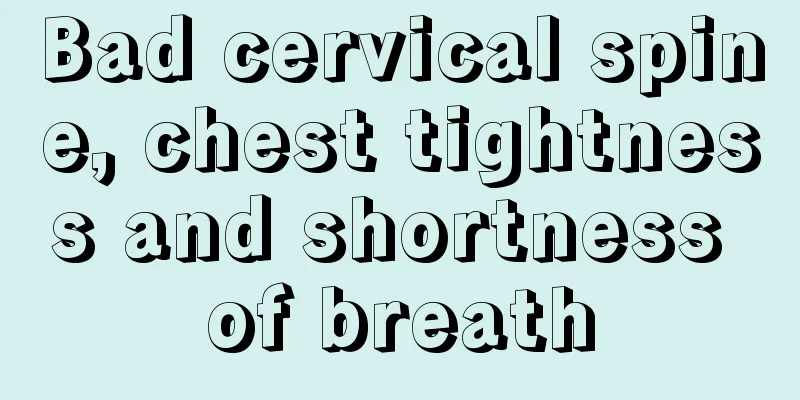Bad cervical spine, chest tightness and shortness of breath

|
People's long working hours and incorrect sitting posture can easily lead to cervical spondylosis. Patients with cervical spondylosis generally experience chest tightness and shortness of breath, and they also experience nausea, vomiting, and even difficulty swallowing when eating. Some women who suffer from cervical spondylosis not only suffer from symptoms such as high blood pressure, but also experience intermittent pain in their breasts. Chest tightness and shortness of breath is one of the symptoms of cervical spondylosis, but it cannot be determined solely based on chest tightness and shortness of breath that it is cervical spondylosis. Other symptoms of cervical spondylosis: 1. Dysphagia Symptoms include itching in the throat, a foreign body sensation, difficulty swallowing, intermittent attacks, sometimes mild, sometimes severe, most obvious when turning the head to the left, and accompanied by nausea and vomiting. According to recent clinical statistics, about 1.6% of patients with cervical spondylosis have this symptom. 2. Hypertension Cervical spondylosis can cause high or low blood pressure, but the former is more common and is called cervical hypertension. This is related to bone stimulation of the sympathetic nerves. At this time, antihypertensive drugs alone are ineffective for patients, and blood pressure will drop spontaneously after treatment of cervical spondylosis. Cervical spine X-ray can confirm the diagnosis. Breast pain It is caused by bone hyperplasia compressing the nerve roots of the 6th and 7th cervical vertebrae. You may start to feel pain in one breast or pectoralis major muscle, which may be intermittent, dull or intermittent, and may be most obvious when you turn your head to one side. Sometimes the pain is unbearable. If this pain occurs on the left side, it is easy to be misdiagnosed as angina pectoris. If it occurs on the right side, it is misdiagnosed as pleurisy. However, the chest X-ray and electrocardiogram examinations are normal. The chest pain can gradually disappear if treated for cervical spondylosis. (IV) Paralysis of lower limbs or defecation disorder It is caused by stimulation of the lateral vertebral bundle of the spinal cord. Patients experience numbness, pain, weakness, and limp in their upper limbs, and most neck symptoms are mild and easily masked. Some are accompanied by frequent urination, urgency, incomplete urination or incontinence. 5. Visual impairment Cervical spondylosis can also manifest as decreased vision, intermittent blurred vision, swelling and pain in one or both eyes, photophobia, tearing, narrowed visual field, and in severe cases, blindness. This visual impairment is related to autonomic dysfunction caused by cervical spondylosis or ischemia of the brain's visual center. Vision can be restored quickly after bone hyperplasia is eliminated, but blindness is not easy to reverse. (VI) Sudden fall It is caused by the compression of the vertebral artery by the proliferating bone and is easily misdiagnosed as cerebral arteriosclerosis or cerebellar disease. People often collapse suddenly when they suddenly turn their heads while walking, often without coma, but with severe dizziness or headache, nausea, vomiting, sweating, etc. |
<<: Purple lips and chest tightness
>>: Hiccups, fullness, chest tightness, and palpitations
Recommend
How is spinal muscular atrophy treated?
I have spinal muscular atrophy and the prognosis ...
How is thyroid cancer caused
How is thyroid cancer caused? Thyroid cancer is a...
How to make hair fluffy when it is close to the scalp
Nowadays girls are more concerned about the probl...
What's the matter with letting out a breath
Long-lasting breath is caused by poor circulation...
The efficacy and function of the sea sparrow
Sea sparrow is salty and warm in nature. It has t...
In addition to ginger honey water to remove acne marks, what else can you do
Many people have varying degrees of acne scars on...
The benefits of foot soaking in summer
Many people have the habit of soaking their feet ...
What should I do if I have heart pain due to myocardial ischemia?
Myocardial ischemia is a manifestation of insuffi...
Rectal cancer symptoms
Rectal cancer symptoms: Symptoms of colorectal ca...
The neck is stiff and there is a clicking sound when it rotates
People who sit in offices or use computers for lo...
What factors can induce the occurrence of skin cancer
Among cancer diseases, I believe everyone should ...
Differential diagnosis method of glioma
Glioma is the most common type of primary brain t...
What are the symptoms of cerebral ischemia
Cerebral ischemia is a relatively common acute ce...
What are the symptoms of lumbar nerve compression
The lumbar spine is a relatively strong bone supp...
What are the dangers of teeth cleaning
Teeth are very important parts of our body. Once ...









